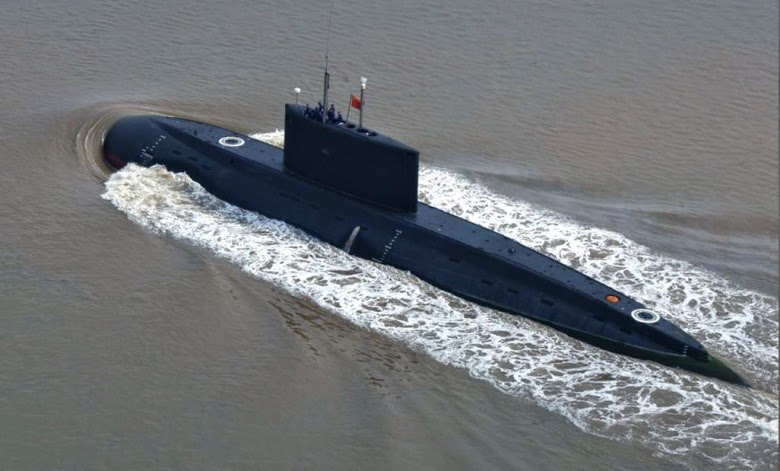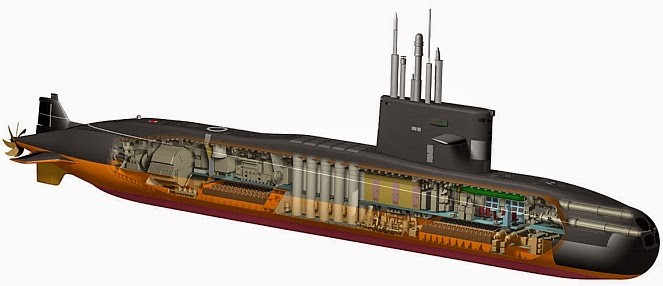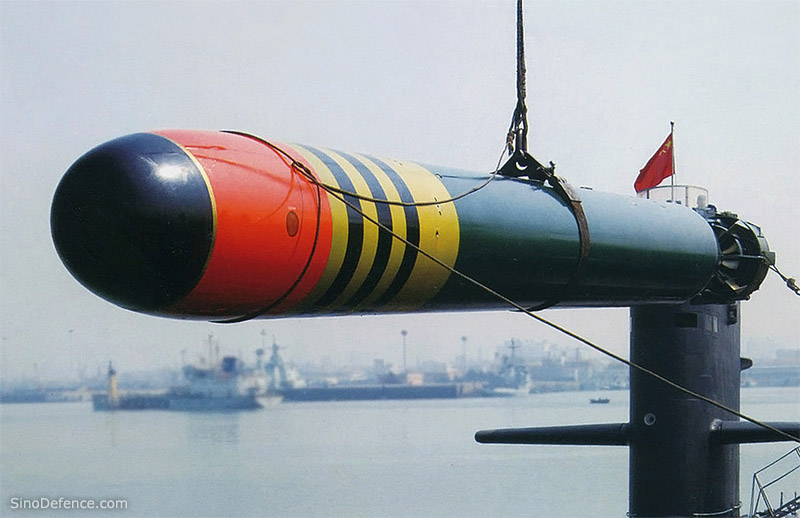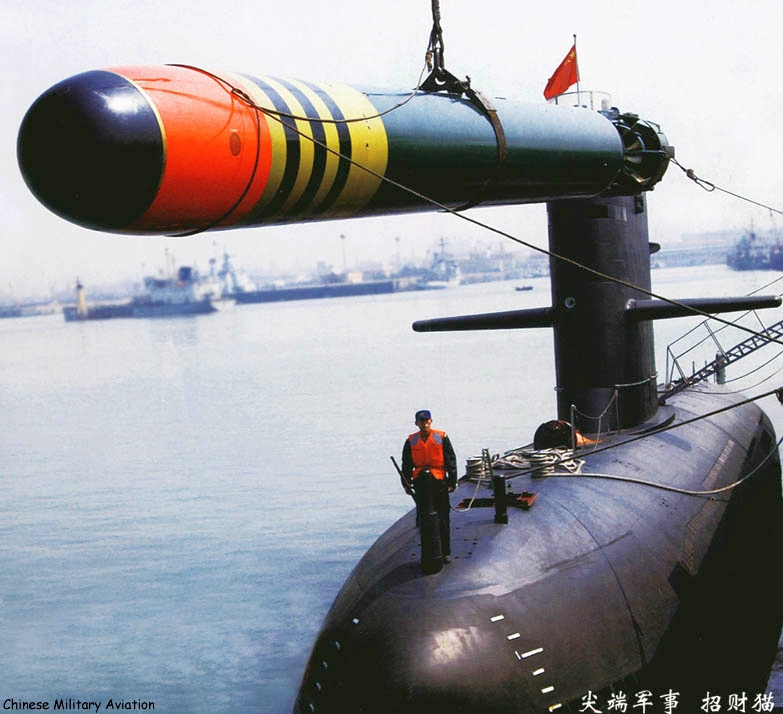YJ-82
من ضمن تسليح الغواصة
Since the late 1970s, the PLAN had eagerly sought to develop a submarine-launched ASCM. But it wasn’t until the YJ-8 program got started that they finally had a weapon they could work with. The Styx-based missiles were far too big, and there were significant safety concerns with putting volatile liquid-fueled missiles on submarines. The small, solid rocket-fueled YJ-8 was exactly what the PLAN was looking for. Their first effort, however, was somewhat half-hearted.
In the fall of 1983, the PLAN accepted delivery of a modified Type 033 Romeo class submarine with six external missile tubes for launching the YJ-8. The new Type 033G submarine began test-firing trials in 1985, and while the launch system appears to have functioned adequately, there was one fatal flaw that effectively ended further development – the submarine had to surface to fire. With a range of only 42 km (22.7 nm), the submarine would be highly susceptible to detection by radar and engaged before it could get all its missiles off. According to one Chinese article, the six missiles could be launched in six to seven minutes after the submarine had surfaced. That’s an uncomfortably long time for a submarine to be on the surface, exposed, that close to a hostile surface ship. A submerged launch option had to be developed to enable the submarine to remain stealthy until it was time to fire, as well as giving it a chance of escape after launching its attack.
For reasons that haven’t been revealed, the Chinese chose a torpedo tube launched approach rather than the external tubes popular with Soviet submarines. This certainly alleviated many complicated submarine design issues, but this choice had problems of its own. In the late 1980s, there were only two ASCMs capable of being launched from a submarine torpedo tube, the French SM39 Exocet and the U.S. UGM-84 Harpoon. Both missiles were encapsulated in a sealed canister to protect the missile from the seawater, but they had very different ways of getting the missile out of the water and into the air.
The French SM39 capsule had a small rocket motor that propelled it out of the water, and once airborne, launched the missile. The U.S. Harpoon employed an unpowered buoyant capsule that used stabilizing fins to guide the capsule upward after being ejected from the tube. As soon as the missile broached the surface, a pressure sensor in the capsule’s nose would detect atmospheric pressure and initiated a small charge that would blow the nose cap off. A split-second later, the booster was ignited and the missile would rise skyward.
Obtaining either missile would have been difficult. France and the U.S. had been slowly warming to China, but it was problematic whether either country would be willing to sell the PRC advanced anti-ship missiles – at least at a price the Chinese were willing to pay. And after the Tiananmen Square incident in June 1989, it became even harder as an arms embargo was soon put in place. But China did have a growing relationship with a country that had access to the U.S. missile.
Pakistan is the most likely source of submarine-launched Harpoon technology that was transferred to China. The two nations were drawing closer to each other diplomatically and militarily due to their mutual concern over India, and the Pakistani Navy’s Agosta and Daphne class submarines had been modified to launch Sub-Harpoon missiles between 1984 and 1986. An additional motivating factor was China’s considerable technical assistance to Pakistan’s nuclear and ballistic missile programs. A quid pro quo arrangement for Chinese engineers to exam and/or dissect a Sub-Harpoon missile would not have been an outrageous request.
Western reporting put the first test firing of a YJ-82 in 1997 from the lead Song (Type 039) class submarine. Limited information suggests the initial flight tests didn’t go well. It wasn’t until 2004, at the Zhuhai Airshow China exposition, that the first photo of a model YJ-82 was seen in a CPMIEC brochure. The photo showed a YJ-8 type missile, without a booster, in an unpowered capsule that is an almost exact duplicate of the U.S. Sub-Harpoon system (see Figure 6). Subsequent Internet photos of encapsulated YJ-82 missiles are consistent with the brochure model, and the length of these capsules is virtually the same as the 6.1-meter submarine-launched encapsulated Harpoon missile. Photos of actual launches show a YJ-8 type missile, sans booster, rising from the ocean surface, very similar to submarine-launched Harpoon firings.
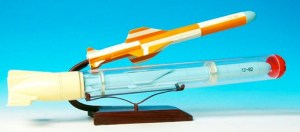
Figure 6: Model of the YJ-82 and its submarine torpedo tube launch canister. Note the lack of a booster on this missile.
Chinese internet courtesy of Christopher P. Carlson
Figure 7 is a photo of an actual YJ-82 missile, and it has all the features of a rocket-propelled missile. The section aft of the wings is short, there isn’t a turbojet scoop, and while the underbelly cable run can’t be seen from this angle, the missile model in Figure 6 does show it. This finding conclusively counters one of the most popular myths propagated in the Western press and on many Internet sites; the YJ-82 cannot be the indigenous version of the export C802 –the two missiles are launched from very different platforms and have radically different propulsion plants. Furthermore, the designation C801Q starting showing up in Western articles and Internet blog sites around the same time and was described as a submarine-launched missile. Reportedly the “Q” means Qian, or submarine. The YJ-82 is most definitely a C801 type missile that is submarine launched, hence the C801Q designation undoubtedly represents the export version.

Figure 7: The YJ-82 is a rocket-propelled missile, and therefore, cannot be the indigenous version of the turbojet-propelled C802. Chinese internet courtesy of Christopher P. Carlson
As for the other related designator, YJ-8Q, this falls into the same category as the YJ-8K. A knowledgeable outside source added the “Q” behind the YJ-8 designation to distinguish it as a submarine-launched weapon. This was probably a well-intentioned attempt to help reduce the confusion, but nonetheless, it is still inaccurate.





